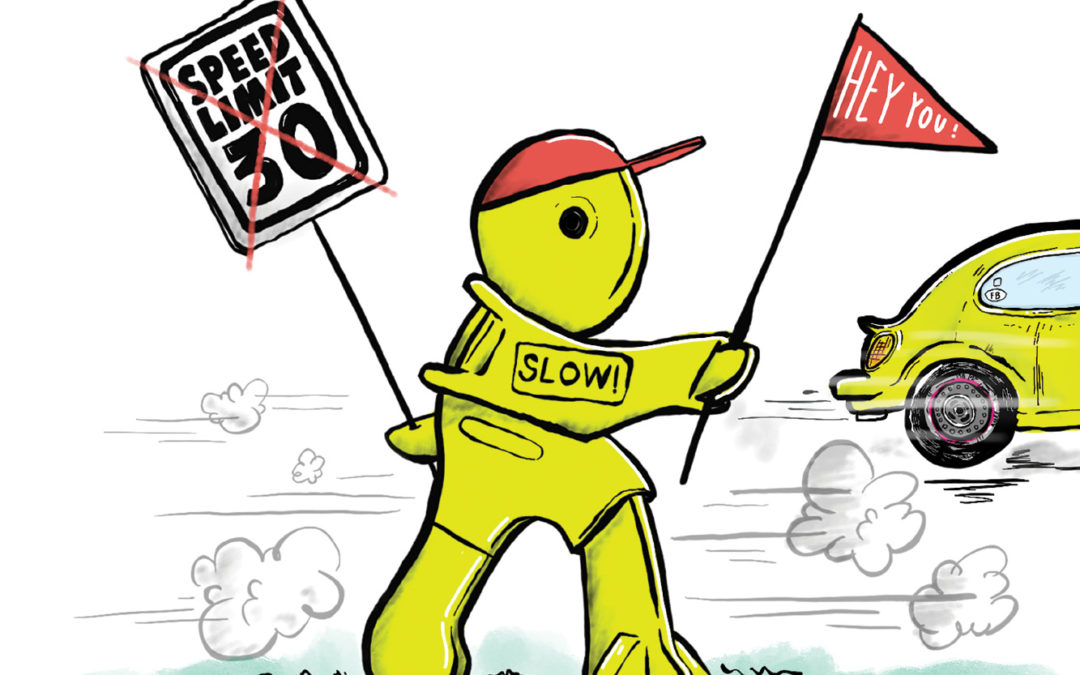Council pushes to reduce the speed limit to 20 mph
By Bill Davis | Current Staff Writer
Pretty soon, everyone on Folly Beach could be driving 20 m.p.h., whether they like it or not. As long as the S.C. Department of Transportation agrees with newly-elected City Councilwoman Amy Ray.
Ray, inspired mightily by protecting kids and pedestrians on the island, campaigned successfully to be elected to council in April.
The biggest plank in her campaign was lowering speed limits so kids like her three children would be safer playing in local playgrounds and riding their bikes in the street.
Ray joined with other mothers, transforming “Relax. Slow Down, it’s Folly” into a successful campaign slogan. And four weeks after she got sworn in, Ray won yet another campaign.
Last month, council voted to request the state agency to change the island-wide maximum speed limit to 20 m.p.h. on both Center Street and the residential areas.
Currently, the speed limit on Center Street is 25 m.p.h. and 30 m.p.h. Initially, the idea on council was to drop each only 5 m.p.h. . Ray thought now was the time to make a ask and hope DOT goes for it or meets them in the.
Lisa Strauss was one of the mothers Ray bonded with over the issue, watching cars whizz by the pirate playground while their kids had a good time.
“It’s just commonsense as a mom and as a person on the East side of the island where we have no sidewalks,” says Strauss, with four kids in tow at the playground, with only two of them her own. “Nowhere to walk on the side of the road, with children, visitors, and partiers all in the street … it’s dangerous.”
Ray wants the city to be proactive instead of reactive, and act before a tragedy occurs. Additionally, a recently completed study also suggests the island could go lower than 20 m.p.h. in some areas.
“There is data that if someone gets hit by a car going 30 m.p.h., their chances of survival would be cut in half, and they probably will not survive,” claims Ray. “But if the car is only going 20 m.p.h., they will most likely survive.”
Ray and Strauss both argue that the difference in commute times is negligible, even from the far ends of the islands., and that the tradeoff for safety makes the change more than worthwhile.
Just because the city has asked for a reduction it does not mean the DOT will agree, says Mayor Tim Goodwin. “They could just say no,” he says, and then nothing would change.
This is not the first time that council has considered asking for a speed limit reduction. Three years ago, council first discussed it, sent a letter to DOT, and soon discovered that the state agency wouldn’t budge on their request without a traffic study in hand.
And so, it died. But this time the city was able to scrap together enough money to hire a local traffic engineer, Howard Chapman, who used to be the head of the Charleston Area Regional Transportation Authority, or CARTA.
Goodwin says the study used the same program that the state uses in determining proper speed limits and should result in “something the DOT can live with.” That study came back with a 20 m.p.h.-limit on Center Street and 25 m.p.h. everywhere else.
Ray thought, and the majority of council agreed, that now was the time to make a bigger “ask” and hope DOT goes for it or meets them in the middle.
But is 20 m.p.h. something everyone on Folly can live with? Goodwin says he would have been speeding the other day in his golf cart when he passed a speed check sign that said he was going 22 m.p.h.
The mayor went on to say that the last few vehicle/pedestrian accidents were complicated incidents that didn’t involve any playgrounds, children, or daylight.
The mayor says they involved speeding, alcohol, and adults. Goodwin adds that he is far from perfect when it comes to speeding and relates an incident that occurred before he took office as mayor and was still serving on council.
“I got caught by a citizen for speeding and called out at a City Council meeting,” he says. “They were right, and I apologized profusely.”
City Councilman DJ Rich was one of two “no” votes on the matter. Rich says he wants a “multi-prong” approach to dealing with speeding on the island that includes more enforcement, reduced speed zones, and maybe speed bumps.
Enforcement may not be an issue. According to the city’s 2017 annual report, 1,116 citations or warnings for speeding had been issued by city police. A deeper dive into those numbers show that 39 percent of those citations, 435 to be exact, were issued on residential streets.
Again, the letter to DOT is just a request. There is no guarantee the state agency will agree and allow the speed limits to be reduced, even a little. So, before you go and rev up your bitchin’ Camaro, “Relax. Slow down … it’s Folly.”


